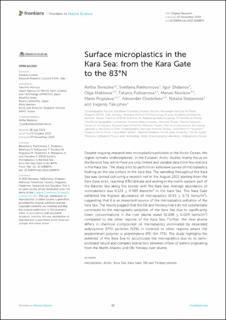| dc.contributor.author | Berezina, Anfisa | |
| dc.contributor.author | Pakhomova, Svetlana | |
| dc.contributor.author | Zhdanov, Igor | |
| dc.contributor.author | Mekhova, Olga | |
| dc.contributor.author | Polivanova, Tatiana | |
| dc.contributor.author | Novikov, Matvei | |
| dc.contributor.author | Pogojeva, Maria | |
| dc.contributor.author | Osadchiev, Alexander | |
| dc.contributor.author | Stepanova, Natalia | |
| dc.contributor.author | Yakushev, Evgeniy | |
| dc.date.accessioned | 2023-11-15T08:19:19Z | |
| dc.date.available | 2023-11-15T08:19:19Z | |
| dc.date.created | 2023-11-14T11:34:28Z | |
| dc.date.issued | 2023 | |
| dc.identifier.citation | Frontiers in Marine Science. 2023, 10:1268879. | en_US |
| dc.identifier.issn | 2296-7745 | |
| dc.identifier.uri | https://hdl.handle.net/11250/3102614 | |
| dc.description.abstract | Despite ongoing research into microplastics pollution in the Arctic Ocean, the region remains underexplored. In the Eurasian Arctic studies mainly focus on the Barents Sea, while there are only limited and variable data from few stations in the Kara Sea. The study aims to perform an extensive survey of microplastics floating on the sea surface in the Kara Sea. The sampling throughout the Kara Sea was carried out using a neuston net in the August 2021 starting from the Kara Gate strait, reaching 83N latitude and ending in the north-eastern part of the Barents Sea along the border with the Kara Sea. Average abundance of microplastics was 0.124 ± 0.383 items/m3 in the Kara Sea. The Kara Gate exhibited the highest abundance of microplastics (0.93 ± 0.73 items/m3), suggesting that it is an important source of the microplastics pollution of the Kara Sea. The results suggest that the Ob and Yenisey rivers do not substantially contribute to the microplastic pollution of the Kara Sea due to significantly lower concentrations in the river plume water (0.008 ± 0.009 items/m3) compared to the other regions of the Kara Sea. Further, the river plume differs in chemical composition of microplastics dominated by expanded polystyrene (EPS) particles (52%) in contrast to other regions where the predominant polymer is polyethylene (PE) (64-77%). The study highlights the potential of the Kara Sea to accumulate the microplastics due to its semi-enclosed nature and complex interaction between inflow of waters originating from the North Atlantic and Ob-Yenisey river plume. | en_US |
| dc.language.iso | eng | en_US |
| dc.publisher | Frontiers | en_US |
| dc.rights | Navngivelse 4.0 Internasjonal | * |
| dc.rights.uri | http://creativecommons.org/licenses/by/4.0/deed.no | * |
| dc.title | Surface microplastics in the Kara Sea: from the Kara Gate to the 83°N | en_US |
| dc.type | Peer reviewed | en_US |
| dc.type | Journal article | en_US |
| dc.description.version | publishedVersion | en_US |
| dc.rights.holder | © 2023 The Authors | en_US |
| dc.source.pagenumber | 11 | en_US |
| dc.source.volume | 10 | en_US |
| dc.source.journal | Frontiers in Marine Science | en_US |
| dc.identifier.doi | 10.3389/fmars.2023.1268879 | |
| dc.identifier.cristin | 2196366 | |
| dc.source.articlenumber | 1268879 | en_US |
| cristin.ispublished | true | |
| cristin.fulltext | original | |
| cristin.qualitycode | 1 | |

